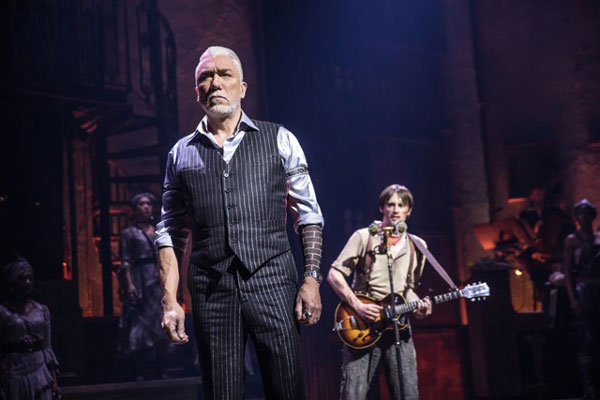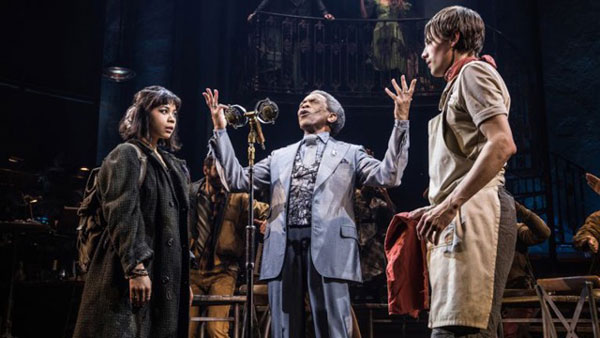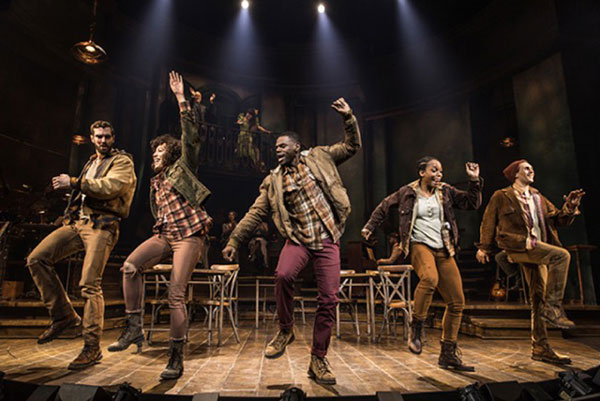|
The ancient myth of Orpheus holds a perennial fascination for artists, especially for those wishing to bring the story of the poet-musician’s hell-defying passion for his beloved Eurydice to the stage. From Gluck’s 1762 opera seria to Offenbach’s comic rendition, Orpheus in the Underworld, to Tennessee Williams’ Orpheus Descending, this tale of enduring love, hubris, human weakness, and the power of song to penetrate even the fires of hell proves as contemporary now as it did in Antiquity.
No small wonder then that Anaïs Mitchell’s musical, Hadestown, has garnered such praise and attention. Mitchell’s work, which began with a small Vermont workshop in 2006, followed by a tour and a 2010 concept album, finally made it to off-Broadway in 2016 and to the Great White Way in 2019, where it garnered eight Tony awards.
With its Motown score and gritty modern urban ambiance, Hadestown is fierce and original, embracing the ancient myth, while layering on the core narrative a compelling sense of spiraling through time. Mitchell intertwines the Orpheus story with that of Persephone, the daughter of Demeter, goddess of the earth, who was abducted by Hades, the god of the underworld to be his bride; their union ultimately resulted in the cycle of seasons with the earth plunged into winter when Persephone was below and with spring returning when she returned to visit her mother. The conflation of these stories reinforces the rhythm of Hadestown. Everything is circular. Spring turns to winter and back to spring. Life transitions to death and again to rebirth, at least in the form of hope.
Mitchell’s book sets the tale in a post-apocalyptic, industrial world where those above struggle for an existence and those in the underworld are ruled by the tyrant Hades. Only the poet Orpheus clings to a vision that is pure, inspiring, and grounded in love. The score is through-composed with lyrics that range from rap to solos and choral pieces that recall the use of the Greek chorus in ancient drama. The musical style has the earthiness and propulsive rhythms of Motown, and is masterfully played by the onstage band that weaves a colorful soundscape with piano, accordion, violin, cello, guitar, trombone, glockenspiel, double bass, drums and other percussion. Instead of the lyre, Orpheus plays guitar, and his solos are appropriately luminous moments in an otherwise often dense and dark musical tapestry. The same can be said of Mitchell’s vocal writing, which employs a wide range
of voice colors and types, relying strongly on the contrast of Hades’ basso profundo with Orpheus’ high lyric tenor.

The Broadway production at the Walter Kerr Theatre has a sense of intimacy and immersion for the audience. Everything about the production reinforces the sense of circularity from Rachel Chavkin’s staging, to David Neumann’s muscular, modern choreography, to Rachel Hauch’s set with its turntable downstage that is incorporated into the actors’ movement, as well as used for scene transitions. Hauch also creates the sense of depth from the underworld to the world above with a steep, spiraling staircase and upper balcony and with the trap door pit that allows platforms and actors to descend into a vortex. Bradley King completes the effect with his atmospheric lighting and memorable special effects such as the swaying overhead lamps that join a choreographed sequence with the actors in Hades or the quadrants of headlight-like lamps that penetrate the shadows at various points.
Michael Krass’ costumes provide a suitable mélange of styles from the glitzy wear of the Apollo Theatre, to Caribbean colorfulness, to Soho chic and Bohemian tatters.
The cast is a tight-knit, very diverse ensemble. André De Shields gives a limber, appropriately mercurial performance of Hermes – smooth and savvy of speech, lithe and limber of movement. Patrick Page proves a dominating presence as Hades with a bass voice that sends chills in both its gravely speech and its rich, chocolaty singing. Amber Gray is a sultry, worldly-wise Persephone, while Eva Noblezada makes Eurydice a waif-like creature with powerful vocal and emotional range. Only Reeve Carney as

Orpheus fails to convince this critic. He surely possesses the sweet gaucheness and sincerity of the role, but he seemed to fall short of the vocal challenges of the part – his voice never achieving the seamlessness it needs to master the range all the way up into the above-the-staff head voice sections. Still, he offers enough of a contrast as the pure, naïve poet to make the narrative work.
The supporting ensemble is all strongly cast. The trio of Fates, Jewelle Blackman, Yvette Gonzalez-Nacer, and Kay Trinidad, are vocally impressive, omniscient and straight-talking fogures used as the Greek chorus. The workers’ chorus includes electric singer-dancers Anthony Chatmon II, Timothy Hughes, John Krause, Damani Van Rensalier, and Kim Steele with swings Malcolm Armwood, T. Oliver Reid, Jessie Shelton, and Khaila Wilcoxon.

Hadestown draws its inspiration from Greek tragedy, and even in this modern retelling, there are gasps from the audience (presumably those unfamiliar with the story) when Orpheus breaks the spell, looks back at Eurydice too soon, and condemns her to return to the underworld. Because Anaïs Mitchell has written a work for musical theatre, but also because this is her modern message, she tempers the gravitas of that tragedy with faith. In choosing to retell Orpheus’ story, she cherishes the hope that things may turn out differently this time. Hermes says, No matter how many times they sing it, people always hope for a happy ending…..They long to see what the world could be in spite of what it is.
And so Hadestown, at the conclusion of the mythic tale and the bows, the cast steps out toward the audience and raises a glass to toast with them. They sing a paean to Orpheus, to the light he represents, to the power of song and art to create new reality and transform human lives, and to the spirit of eternal hope that defies darkness.
|